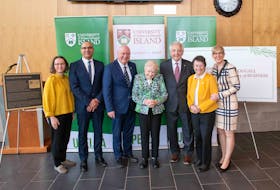Sgt. (Ret’d) Garry Randall of Kentville and Col. (Ret’d) Ron Stonier of Coldbrook, members of the regiment’s history committee, said the exhibit pays tribute to Canadian snipers, particularly those who served with the West Novas.
Stonier said one icon among our Second World War veterans is scout-sniper Pte. Oren Foster of Deep Brook, originally of Karsdale, who passed away in 2010. Foster joined the war in 1939 and was part of the first draft to go overseas. He stayed with the West Nova Scotia Regiment and came home with them in October 1945.
“He was never wounded and he was there for work every day,” Stonier said.
One act of bravery that made Foster stand out occurred when a boat overturned during a salt river crossing exercise in England. Foster couldn’t swim but paddled out in a boat and saved the lives of four fellow soldiers.
“For that act of valour or bravery, he was awarded the British Empire Medal,” Stonier said.
King George VI presented the medal at Buckingham Palace.
The invitation, along with several other items that belonged to Foster, is part of the exhibit.
“He said it was the biggest thing that ever happened in his life, his greatest memory,” Randall said.
Foster always said he’d rather go out and bring an enemy back alive because he didn’t want to be known as a murderer.
“If he had that choice, he made it available to the enemy,” Randall said. This was probably a greater risk to Foster’s own life.
“He was good at what he did by the sounds of it.”
Randall said sometimes sniper-scouts would also be sent out at night to try to find soldiers stranded on the battlefield. It’s impossible to say how many lives Foster – and others like him - saved by performing various responsibilities.
There was always a desire for the regimental association to have its own museum at Camp Aldershot. Part of the history committee’s mandate is keeping the history of the West Nova Scotia Regiment alive and they have many artefacts.
After it became apparent they wouldn’t have a museum of their own, the members conducted an artefact assessment and took the idea of an exhibit to a few Valley museums.
They partnered with the Kings Historical Society to make the Canadian Sniper exhibit a reality. The exhibit will be at the Annapolis Valley Macdonald Museum in Middleton next year.
“There’s something about the military ethos that creates a bond between people. I suppose in wartime when you put your life in someone else’s hands, you never forget it,” Stonier said.
This is the genesis of the regimental association, made up of former members of the regiment.
Randall served with the West Novas for 15 years, from the 1970s to the 1990s, and is a former Senior NCO of the unit. Stonier was commanding officer of the unit from 1986 to 1990 and from 2001 to 2003. He served 41-and-a-half years in the army reserves.
If you go
- The exhibit “SIGHTINGS: Exploring the Scope of the Canadian Sniper in the Second World War” is being hosted by the Kings County Museum at 37 Cornwallis St., Kentville, until Nov. 18.
- Part of the exhibit is a communion set used by Padre L.F. Wilmot, who served with the West Novas from 1944 to 1945, and a sniper rifle with a scope similar to the one used by Foster.
- As part of the Kings Historical Society’s annual general meeting at the museum May 31 at 7 p.m., Stonier will be giving a talk entitled “SIGHTINGS: Exploring the Scope of the Canadian Sniper in the Second World War”. Admission is a freewill offering.
WNSR Scout-Sniper Platoon
Some well-known members of the platoon who served their country during the Second World War include:
- Cpl. Charles Jeremy, Parrsboro, Nova Scotia, wounded on the Arielli Front in March 1944.
- Cpl. Charlie Fleet, Stephenville Crossing, Newfoundland.
- Pte. H.F. Gates, a.k.a. Harry “Snake Eye” Gates, Port Maitland, Nova Scotia.
- Pte. Oren S. Foster, Deep Brook, Nova Scotia.
- Pte. Val Young, Little Bras d’Or, Nova Scotia, wounded at Ortona Dec. 17, 1943.
- Pte. G.K. Langille, Martin’s River, Nova Scotia.
- Pte. R.M. Francis, Lequille, Nova Scotia.
- Pte. D.F. Adams, Kentville, Nova Scotia.
- Pte. Francis H. Doucett, Miscuoche, PEI, killed at the Gothic Line in September 1944.
Sgt. (Ret’d) Garry Randall of Kentville and Col. (Ret’d) Ron Stonier of Coldbrook, members of the regiment’s history committee, said the exhibit pays tribute to Canadian snipers, particularly those who served with the West Novas.
Stonier said one icon among our Second World War veterans is scout-sniper Pte. Oren Foster of Deep Brook, originally of Karsdale, who passed away in 2010. Foster joined the war in 1939 and was part of the first draft to go overseas. He stayed with the West Nova Scotia Regiment and came home with them in October 1945.
“He was never wounded and he was there for work every day,” Stonier said.
One act of bravery that made Foster stand out occurred when a boat overturned during a salt river crossing exercise in England. Foster couldn’t swim but paddled out in a boat and saved the lives of four fellow soldiers.
“For that act of valour or bravery, he was awarded the British Empire Medal,” Stonier said.
King George VI presented the medal at Buckingham Palace.
The invitation, along with several other items that belonged to Foster, is part of the exhibit.
“He said it was the biggest thing that ever happened in his life, his greatest memory,” Randall said.
Foster always said he’d rather go out and bring an enemy back alive because he didn’t want to be known as a murderer.
“If he had that choice, he made it available to the enemy,” Randall said. This was probably a greater risk to Foster’s own life.
“He was good at what he did by the sounds of it.”
Randall said sometimes sniper-scouts would also be sent out at night to try to find soldiers stranded on the battlefield. It’s impossible to say how many lives Foster – and others like him - saved by performing various responsibilities.
There was always a desire for the regimental association to have its own museum at Camp Aldershot. Part of the history committee’s mandate is keeping the history of the West Nova Scotia Regiment alive and they have many artefacts.
After it became apparent they wouldn’t have a museum of their own, the members conducted an artefact assessment and took the idea of an exhibit to a few Valley museums.
They partnered with the Kings Historical Society to make the Canadian Sniper exhibit a reality. The exhibit will be at the Annapolis Valley Macdonald Museum in Middleton next year.
“There’s something about the military ethos that creates a bond between people. I suppose in wartime when you put your life in someone else’s hands, you never forget it,” Stonier said.
This is the genesis of the regimental association, made up of former members of the regiment.
Randall served with the West Novas for 15 years, from the 1970s to the 1990s, and is a former Senior NCO of the unit. Stonier was commanding officer of the unit from 1986 to 1990 and from 2001 to 2003. He served 41-and-a-half years in the army reserves.
If you go
- The exhibit “SIGHTINGS: Exploring the Scope of the Canadian Sniper in the Second World War” is being hosted by the Kings County Museum at 37 Cornwallis St., Kentville, until Nov. 18.
- Part of the exhibit is a communion set used by Padre L.F. Wilmot, who served with the West Novas from 1944 to 1945, and a sniper rifle with a scope similar to the one used by Foster.
- As part of the Kings Historical Society’s annual general meeting at the museum May 31 at 7 p.m., Stonier will be giving a talk entitled “SIGHTINGS: Exploring the Scope of the Canadian Sniper in the Second World War”. Admission is a freewill offering.
WNSR Scout-Sniper Platoon
Some well-known members of the platoon who served their country during the Second World War include:
- Cpl. Charles Jeremy, Parrsboro, Nova Scotia, wounded on the Arielli Front in March 1944.
- Cpl. Charlie Fleet, Stephenville Crossing, Newfoundland.
- Pte. H.F. Gates, a.k.a. Harry “Snake Eye” Gates, Port Maitland, Nova Scotia.
- Pte. Oren S. Foster, Deep Brook, Nova Scotia.
- Pte. Val Young, Little Bras d’Or, Nova Scotia, wounded at Ortona Dec. 17, 1943.
- Pte. G.K. Langille, Martin’s River, Nova Scotia.
- Pte. R.M. Francis, Lequille, Nova Scotia.
- Pte. D.F. Adams, Kentville, Nova Scotia.
- Pte. Francis H. Doucett, Miscuoche, PEI, killed at the Gothic Line in September 1944.








